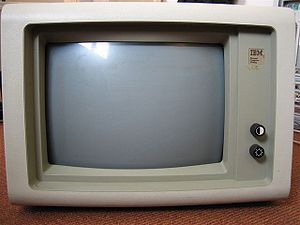
IBM 5151
Encyclopedia

Monochrome monitor
A monochrome monitor is a type of CRT computer display which was very common in the early days of computing, from the 1960s through the 1980s, before color monitors became popular. They are still widely used in applications such as computerized cash register systems...
, shipped with the original IBM Personal Computer.
It only produced green colors because it used P39 phosphor. IBM designed its MDA monochrome display system to deliver extremely well-formed characters for the time. The monitor was meant to be hooked up to an IBM Monochrome Display Adapter which had no graphics modes at all, and only supported the 80 x 25 text mode, using 9 x 14 pixels per character. The Hercules Graphics Card
Hercules Graphics Card
The Hercules Graphics Card was a computer graphics controller made by Hercules Computer Technology, Inc. which, through its popularity, became a widely supported display standard. It was common on IBM PC compatibles connected to a monochrome monitor . It supported one high resolution text mode and...
had its resolution designed around this monitor, allowing cheap high-resolution PC graphics, and some people also used 5151 monitors with CGA or EGA boards for their mono modes.
The monitor has a 11.5-inch wide CRT (measured diagonally) with 90 degrees deflection that is etched to reduce glare. The monitor uses TTL digital inputs through a 9-Pin D-shell connector. It is also plugged into the female AC port on the IBM PC power supply, and thus did not have a power switch of its own.
The IBM monochrome monitor had a resolution of 350 horizontal lines and a 50Hz refresh rate. IBM got around the problem of display flicker
Flicker (screen)
Flicker is a visible fading between cycles displayed on video displays, especially the refresh interval on cathode ray tube based computer screens. Flicker occurs on CRTs when they are driven at a low refresh rate, allowing the brightness to drop for time intervals sufficiently long to be noticed...
by using high-persistence P39 phosphor that retain energy for a long period of time as the electron beam draws the image on-screen. However, this creates a detrimental effect of smearing when the displayed image changes rapidly, or "tails" associated with moving images.
Although generally reliable, the high voltage transformer ('flyback transformer') TFB648 in this terminal was recognised as the most common reason for rare failures.
Specifications
| Type | Digital, TTL |
|---|---|
| Resolution | 720h × 350v |
| Size | 280mm (H) x 380mm (L) x 350 mm (D) |
| Weight | 7.9kg |
| Heat output | 325 BTU/Hr |
| H-freq | 18.432 kHz |
| V-freq | 50 Hz |

